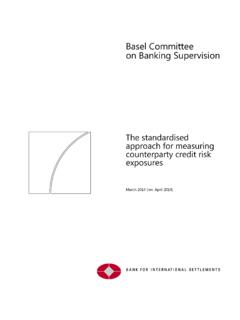Transcription of CREDIT RISK MODELLING: CURRENT PRACTICES AND …
1 CREDIT RISK MODELLING: CURRENT PRACTICESANDAPPLICATIONSB asle Committee on Banking SupervisionBasleApril 1999 TABLE OF CONTENTSList of ParticipantsExecutive SummaryPart I:Introduction1. Overview .. 82. Internal Applications of CREDIT Risk Models .. 93. Key Challenges to Regulatory 104. Organisation of Report .. 11 Part II:Overview of Conceptual Approaches to CREDIT Risk Modelling1. Economic Capital Allocation .. 13A. Probability Density Function of CREDIT Losses .. 13B. Key Issues .. 162. Measuring CREDIT Loss .. 16A. Time Horizon .. 16B. Default-Mode 17An Illustration: The Mean/Standard Deviation 18 Internal Risk Rating Systems, EDFs, Transition 19C.
2 Mark-to-Market Paradigm .. 22 Discounted Contracual Cash Flow 22 Risk-Neutral Valuation 23D. Key Issues .. 243. Probability Density Functions .. 26A. 26B. Key Issues .. 274. Conditional versus Unconditional Models .. 28A. Definition of 28B. Key Issues .. 295. Approaches to CREDIT Risk Aggregation .. 29A. Top-Down and Bottom-Up 29B. Key Issues .. 306. Correlations between CREDIT Events .. 31A. 31B. Cross-Correlations between Different 31C. Correlations Among Defaults or Ratings Migrations .. 32 Structural 32 Reduced-Form 32D.
3 Key Issues .. 33 Part III:Parameter Specification and Estimation1. LGDs (loss rate given defaults).. 35A. Modelling Assumptions .. 36B. Estimation .. 36C. Key Issues .. 372. Defaults/Rating Migrations .. 38A. Estimation of EDFs/Transition Matrices .. 38 Actuarial-Based 38 Equity-Based 39B. Key Issues .. 393. Correlations Among Default and/or Rating Transitions .. 41A. Estimation .. 41 Actuarial-Based 42 Equity-Based 43B. Key Issues .. 434. CREDIT Spreads .. 45A. 45B. Key Issues .. 455. Exposure Levels .. 45A. 45B. Key Issues.
4 466. Implemetation: Data Gathering and System Capabilities .. 47A. Data Availability and System Capabilities .. 47B. Key Issues .. 48 Part IV:Validation1. Summary of Validation Policies and Issues .. 50A. Differences in CREDIT Versus Market Risk 50B. Key Issues .. 502. Backtesting .. 51A. 51B. Key Issues .. 513. Stress Testing .. 53A. 53B. Key Issues .. 534. Sensitivity Analysis .. 53A. 53B. Key Issues .. 535. Management Oversight and 54A. 54B. Key Issues .. 54 Appendix: Matrix of Key 55 Models Task ForceChairperson:Dani le Nouy, Secretary GeneralBasle Committee on Banking SupervisionCommission Bancaire et Financi re, BrusselsPatrick MassinOffice of the Superintendent of Financial Institutions, OttawaRichard GresserCommission Bancaire,Evelyn GuillyParisC.
5 K. TranDeutsche Bundesbank, Frankfurt am MainRoland RaskopfBundesaufsichtsamt f r das Kreditwesen, BerlinUwe TraberBanca d Italia, RomeSebastiano LaviolaThe Bank of Japan, TokyoAkira IedaFinancial Supervisory Agency, TokyoTomomichi TomiieCommission de Surveillance du Secteur Financier, LuxembourgIsabelle GoubinDe Nederlandsche Bank , AmsterdamAd HuijserFinansinspektionen, StockholmMats StenhammarSekretariat der Eidgen ssische Bankenkommission, BernUwe SteinhauserSwiss National Bank, Z richChristian BraunFinancial Services Authority, LondonAlan CathcartBank of England.
6 LondonPamela NickellBoard of Governors of the Federal Reserve System,James HouptWashington, DCDavid JonesFederal Reserve Bank of New York,Brian PetersNew YorkMarc SaidenbergOffice of the Comptroller of the Currency, Washington, DCRoger TuftsFederal Deposit Insurance Corporation, Washington, DCMiguel BrownSecretariat of the Basle Committee on BankingZahra El-MekkawySupervision, Bank for International SettlementsFormer Members who Participated in the StudyThe Bank of Japan, TokyoNobuyuki OdaFinancial Supervisory Agency, TokyoKozo IshimuraSekretariat der Eidgen ssische Bankenkommission, BernSusanne BrandenbergerSwiss National Bank, Z richChristian WalterOffice of the Comptroller of the Currency, LondonRon PaschSecretariat of the Basle Committee on BankingErik Musch (former Chairperson)Supervision, Bank for International SettlementsKim OlsonCredit Risk Modelling.
7 CURRENT PRACTICES and ApplicationsExecutive and objectivesOver the last decade, a number of the world s largest banks have developedsophisticated systems in an attempt to model the CREDIT risk arising from important aspects oftheir business lines. Such models are intended to aid banks in quantifying, aggregating andmanaging risk across geographical and product lines. The outputs of these models also playincreasingly important roles in banks risk management and performance measurementprocesses, including performance-based compensation, customer profitability analysis, risk-based pricing and, to a lesser (but growing) degree, active portfolio management and capitalstructure decisions.
8 The Task Force recognises that CREDIT risk modelling may indeed prove toresult in better internal risk management, and may have the potential to be used in thesupervisory oversight of banking organisations. However, before a portfolio modellingapproach could be used in the formal process of setting regulatory capital requirements forcredit risk, regulators would have to be confident not only that models are being used toactively manage risk, but also that they are conceptually sound, empirically validated, andproduce capital requirements that are comparable across institutions.
9 At this time, significanthurdles, principally concerning data availability and model validation, still need to be clearedbefore these objectives can be met, and the Committee sees difficulties in overcoming thesehurdles in the timescale envisaged for amending the Capital have already been incorporated into the determination of capital requirementsfor market risk. However, CREDIT risk models are not a simple extension of their market riskcounterparts for two key reasons: Data limitations: Banks and researchers alike report data limitations to be a keyimpediment to the design and implementation of CREDIT risk models.
10 Most creditinstruments are not marked to market, and the predictive nature of a CREDIT risk modeldoes not derive from a statistical projection of future prices based on acomprehensive record of historical prices. The scarcity of the data required toestimate CREDIT risk models also stems from the infrequent nature of default eventsand the longer-term time horizons used in measuring CREDIT risk. Hence, in specifying2model parameters, CREDIT risk models require the use of simplifying assumptions andproxy data. The relative size of the banking book and the potential repercussions onbank solvency if modelled CREDIT risk estimates are inaccurate underscore the needfor a better understanding of a model s sensitivity to structural assumptions andparameter estimates.












